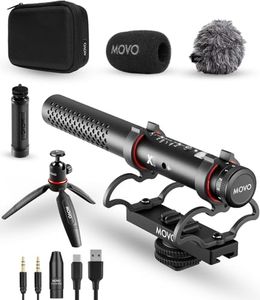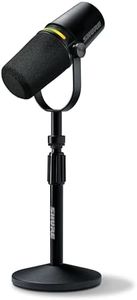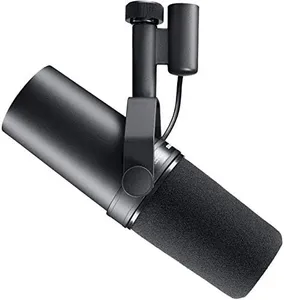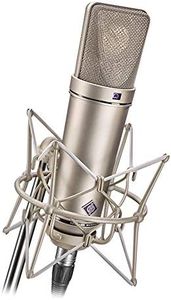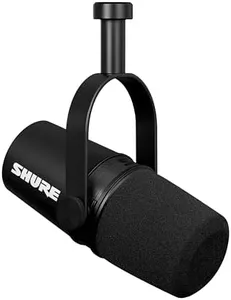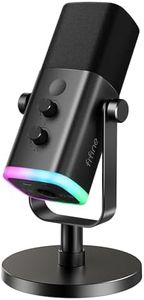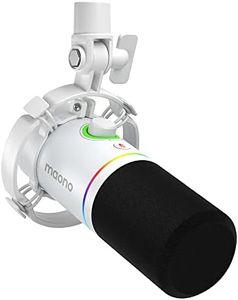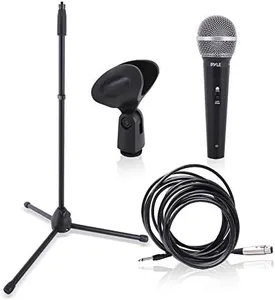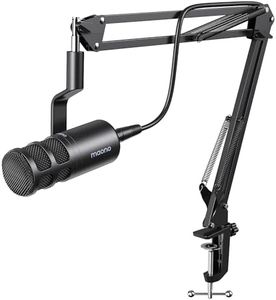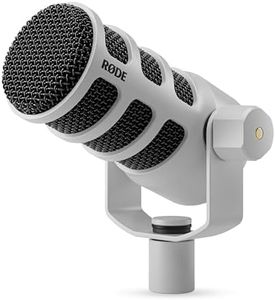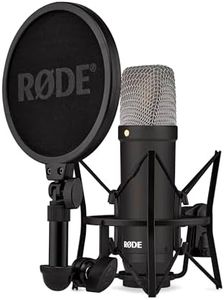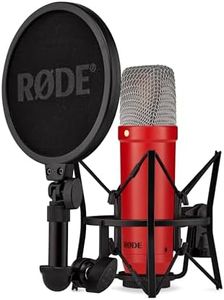10 Best Xlr Microphones 2025 in the United States
Our technology thoroughly searches through the online shopping world, reviewing hundreds of sites. We then process and analyze this information, updating in real-time to bring you the latest top-rated products. This way, you always get the best and most current options available.

Our Top Picks
Winner
Shure MV7+ Podcast Dynamic Microphone with Stand – OBS Certified, Enhanced Audio, LED Panel, USB-C & XLR Outputs, Auto Level Mode, Digital Pop Filter – for Podcasting, Streaming, and Recording, Black
Most important from
3636 reviews
The Shure MV7+ is a solid choice for podcasters, streamers, and content creators looking for clear and professional sound. It uses a unidirectional polar pattern, which helps focus on your voice while reducing background noise — ideal for recording in less-than-perfect environments. The microphone’s built-in digital signal processing (DSP) and voice isolation technology work together to minimize unwanted sounds like room echo and fan noise, so your voice comes through clean and sharp.
Thanks to its flexible USB-C and XLR connectivity, the MV7+ easily adapts from beginner setups to more advanced studio rigs. The included desktop stand adds convenience for table use. Its sensitivity level is good for capturing voice detail without picking up too much ambient noise. The metal build offers durability, making it a reliable tool for regular use. One standout feature is the LED touch panel, allowing you to mute quickly and customize the mic’s appearance with many colors. The updated Auto Level Mode adjusts gain automatically based on how close you are to the mic, which helps maintain consistent volume without manual tweaks. A digital pop filter also smooths out harsh sounds from plosive consonants, improving recording quality.
The microphone offers many professional features like onboard reverb effects and app control for fine-tuning, but it weighs about 3.5 pounds, making it less portable than some lighter options. Also, the multiple settings and app integration might feel a bit overwhelming for complete beginners. The Shure MV7+ is a versatile, well-built microphone that balances ease of use with powerful audio enhancements, making it a great fit for anyone serious about podcasting, streaming, or recording at home or in a studio.
Most important from
3636 reviews
Shure SM7B Vocal Dynamic Microphone – XLR Studio Mic for Podcasting, Recording, Broadcasting, Streaming & Gaming – Smooth, Warm Sound, Rugged Build, Detachable Windscreen, Wide Frequency Range, Black
Most important from
12392 reviews
The Shure SM7B microphone is a highly versatile dynamic mic known for its exceptional quality in various audio settings including studio recording, podcasting, and streaming. Its unidirectional polar pattern effectively minimizes background noise, which is a significant advantage for users who want clear vocal capture without interference. The wide frequency response ensures natural sound reproduction, making it trusted by many professionals in the industry. Additionally, the rugged construction and detachable windscreen enhance its durability, which is important for both studio setups and mobile uses.
The SM7B requires a high gain setting (at least 60dB) to achieve its optimal performance, which may necessitate an additional preamp for users who don’t already have one. This could add to the cost for beginners. While the microphone doesn’t require phantom power, some users may find it limiting if they wish to use it in configurations that typically require phantom power.
The self-noise level is relatively low, making it suitable for professional recordings, but the microphone can be sensitive to plosives, which means careful positioning is key to avoid unwanted sounds. Despite these minor drawbacks, the Shure SM7B remains a top choice for those seeking quality and reliability in their audio equipment. Its balance of features makes it particularly beneficial for vocalists, podcasters, and streamers looking for a dependable microphone that delivers rich, warm sound.
Most important from
12392 reviews
Neumann U87Ai Set Z Multi-Pattern Large Condenser Microphone
The Neumann U87Ai Set Z is a high-end, large diaphragm condenser microphone designed for professional studio use, especially suited for vocal recording. It offers three polar patterns—omni, cardioid, and figure-8—which provide versatility for capturing different sound sources and room environments. Its frequency response extends up to 20 kHz, delivering a balanced and natural sound that is both classic and clear.
With an audio sensitivity of 127 dB and a signal-to-noise ratio of 87 dB, it captures detailed audio with relatively low background noise, although its self-noise level of 38 dB is somewhat higher than some ultra-quiet competitors. The microphone features a durable metal construction with a sleek champagne finish, ensuring a solid and reliable build for long-term use. It uses an XLR connection, which is standard for professional audio setups and compatible with most studio equipment.
Additional features include a mute function and voice-activated recording, offering useful control options depending on the recording scenario. Due to its size and weight (over 4.5 pounds), it is best suited for stationary use on a stand rather than portable setups. While the U87Ai carries a higher price point, it is a legendary choice among singers and recording professionals seeking a classic, well-rounded microphone capable of handling various applications with excellent sound quality and build. Beginners or casual users might find it more microphone than necessary, but it serves as a trusted workhorse for serious vocal or instrument recording.
